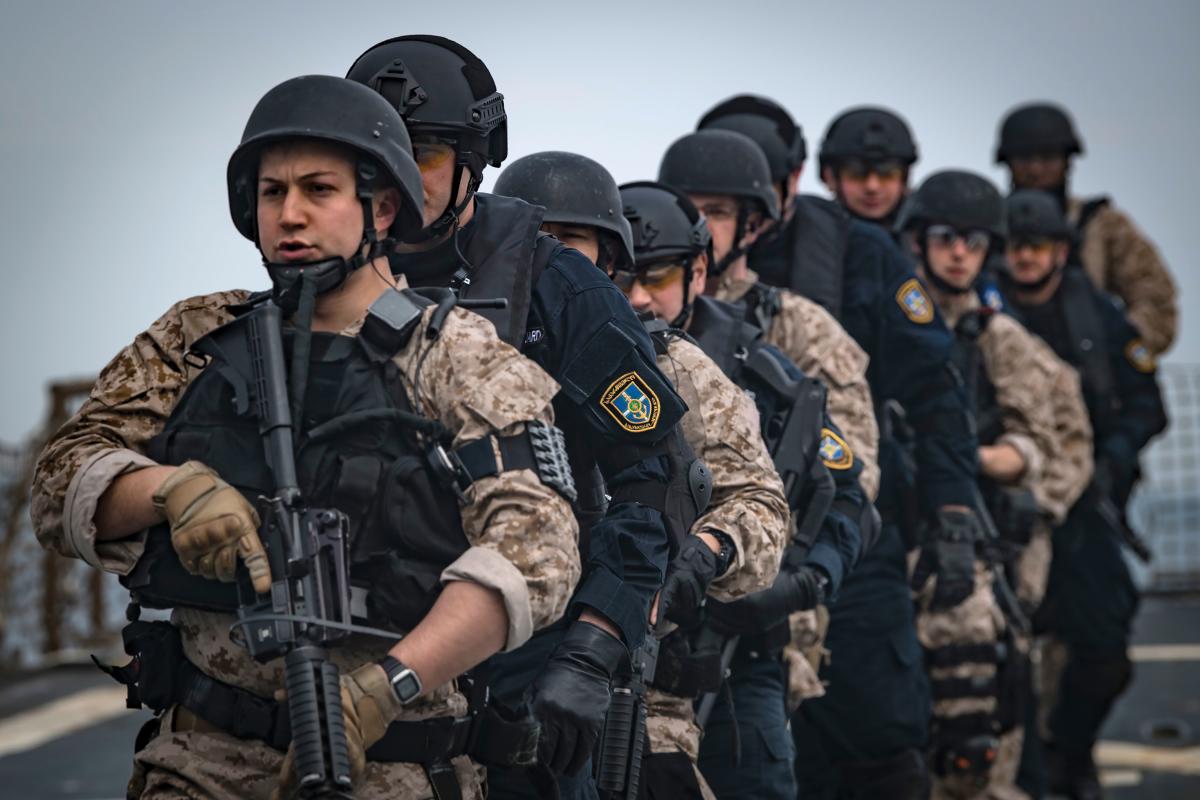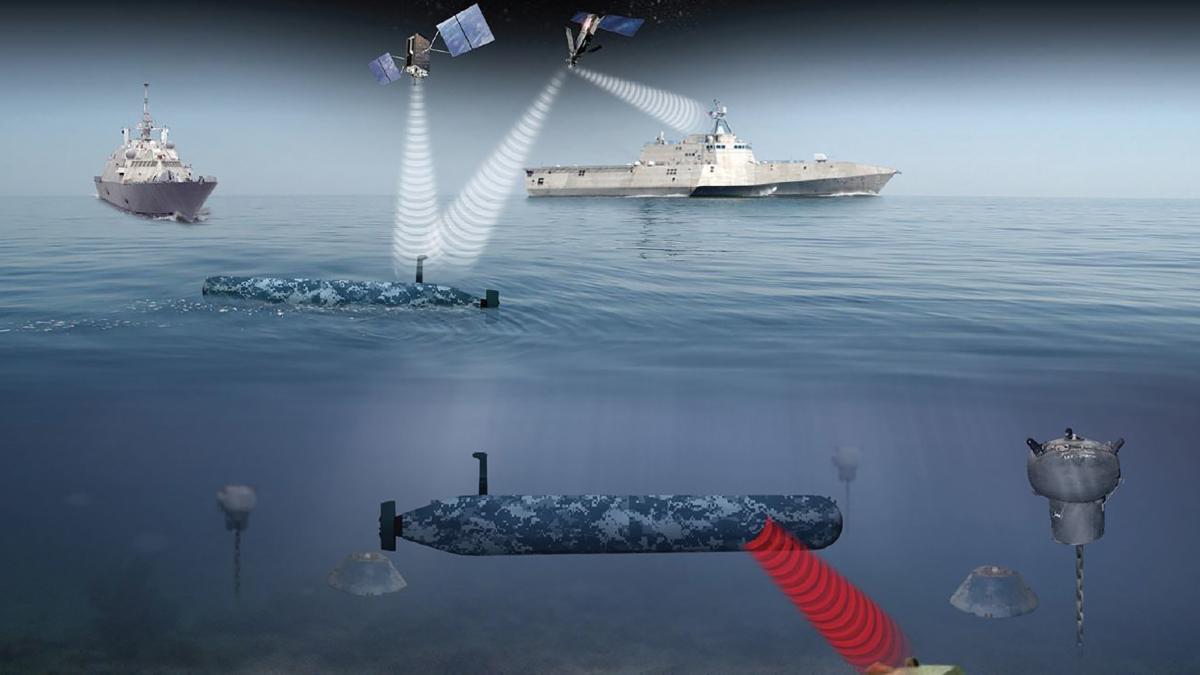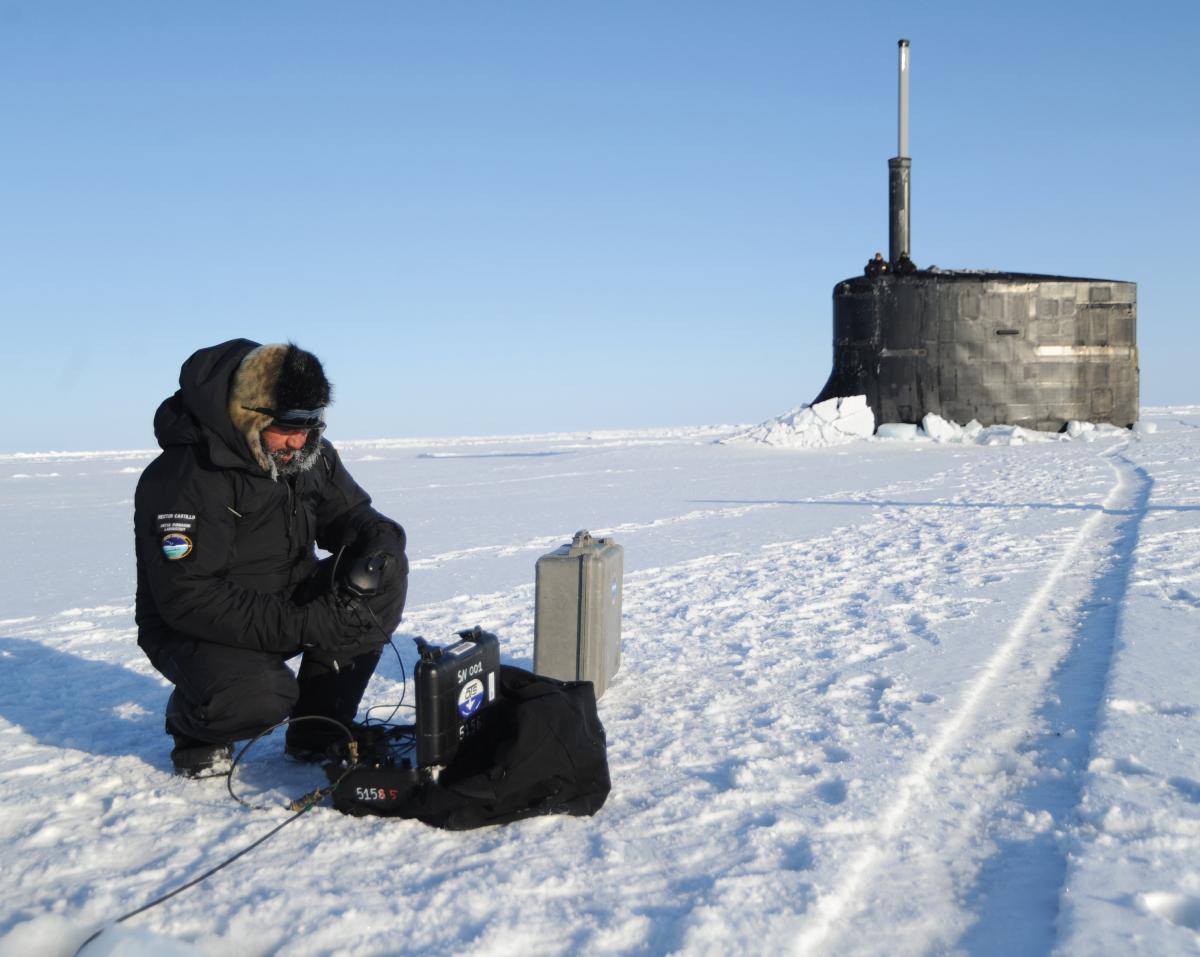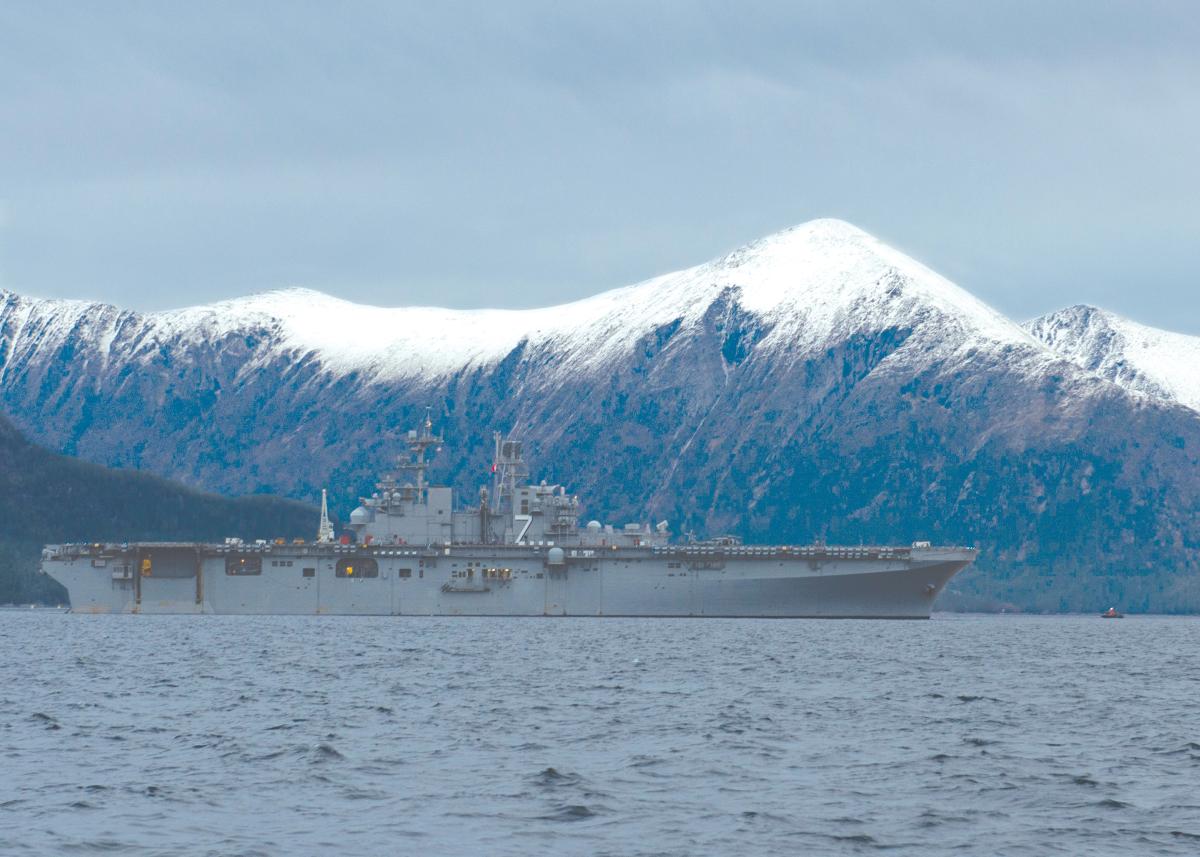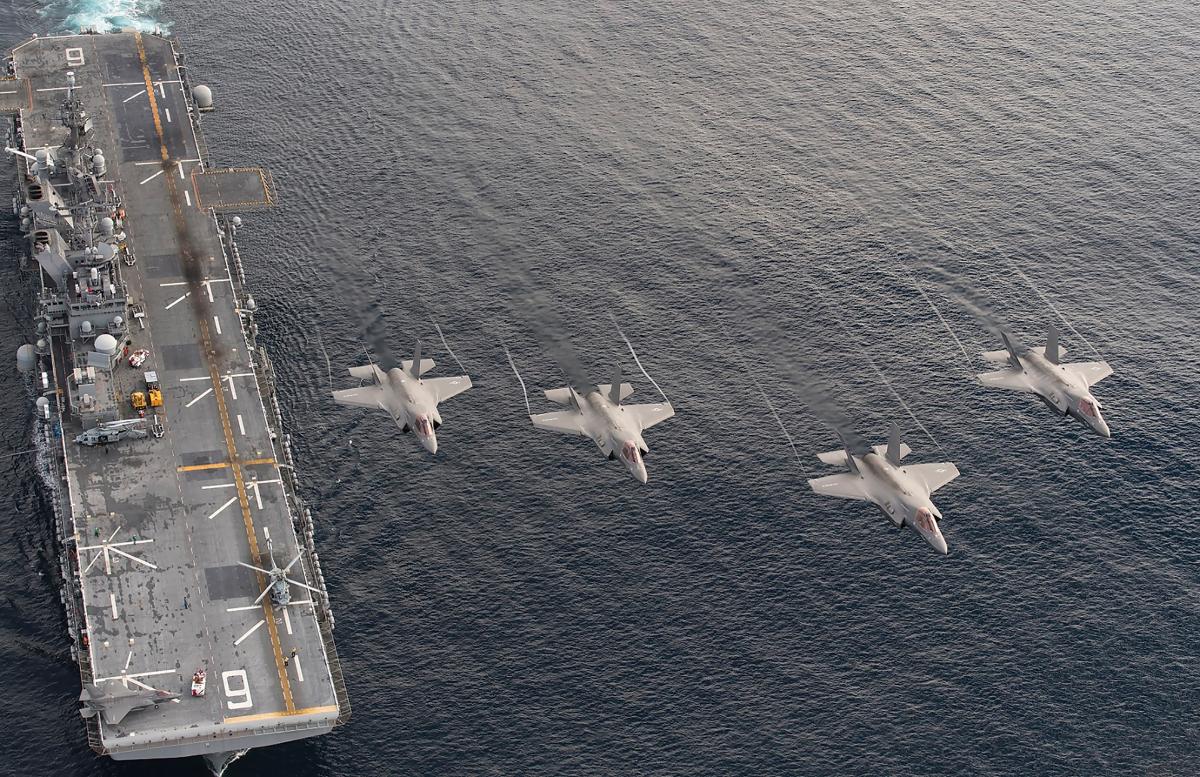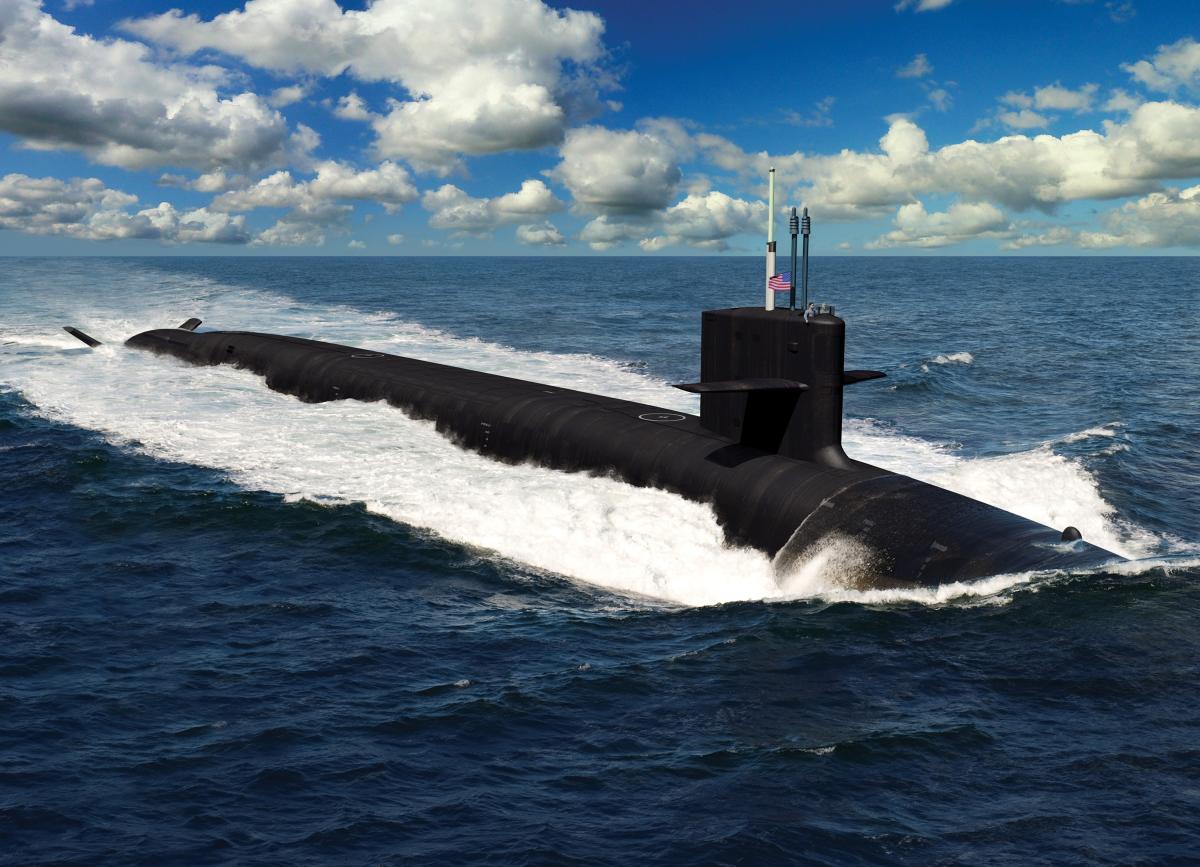During the past year, the U.S. national security community focused on the return of great power competition and how to filter through that long-term competitive lens the improvement of every U.S. Navy element. If, as Robert Kaplan predicts, the Navy will constitute the nation’s “primary strategic instrument, projecting power 24/7 around the globe,” then the service’s geostrategic focus seems dead-on.1
All In on Unmanned Systems
One of the most compelling developments has been the Navy’s enthusiastic embrace of unmanned systems, especially in underwater vehicles (UUVs) and surface vessels (USVs). After years of sometimes fitful support, 2018–19 clearly has demonstrated that the service’s senior leaders are “all in” on unmanned systems as a key component of the future fleet.
Chief of Naval Operations (CNO) Admiral John Richardson’s “Design for Maintaining Maritime Superiority 2.0” directs contract award dates for specific unmanned programs, all of which are then to be delivered to the fleet as soon as possible.2 Seven programs (five UUV/USVs and two unmanned aerial vehicles [UAVs]) were called out in the document:
- Award the Large USV contract in 2023
- Contract for and field the family of UUVs—ORCA, Snakehead, Razorback, and Knifefish—no later than 2025
- Reach MQ-25 Sentinel first flight in 2021 and achieve initial operating capability as soon as possible
- Reach MQ-4C Triton initial operating capability in 2021
In a year marked by significant contract awards, numerous developmental milestones, and continued testing achievements for UAVs and UUVs, the Navy’s plans for its new future surface combatant family proved most interesting. In addition to a traditional large surface combatant, the surface navy intends to build a medium USV and a large USV to enhance the distributed lethality and sensors of the future surface force, based on a modular capability architecture. Navy officials see both unmanned systems as operating in conjunction with manned warships such as the Arleigh Burke (DDG-51)–class destroyer fleet and the future frigate and large surface combatant, but as being less expensive to procure and maintain.
As Rear Admiral Ron Boxall, director of Surface Warfare (N96), told USNI News, going forward, the Navy will ask industry to “tell us what you think about your ability to build different sizes of USVs.” The admiral added, “Look at the capabilities we have on ships today; how would you put some of that on large and medium unmanned? We’re kind of in that same aggressive decision space.”3
Two separate but related experimental prototype efforts—Sea Hunter and Ghost Fleet—aim to help speed development of both medium and large USVs. The Sea Hunter medium-displacement USV, developed by the Defense Advanced Research Projects Agency and then transitioned to the Office of Naval Research and the Maritime Unmanned Systems Office, completed an unmanned deployment from San Diego to Hawaii and back, successfully navigating thousands of miles of Pacific Ocean. Gerry Fasano, defense group president at Leidos, Sea Hunter’s builder, noted “The recent long-range mission is the first of its kind and demonstrates to the U.S. Navy that autonomy technology is ready to move from the developmental and experimental stages to advanced mission testing.”4 A second Sea Hunter is under construction, and test data and operational knowledge will be fed into the medium USV effort.
The Pentagon’s Strategic Capabilities Office is funding a separate USV enterprise called Ghost Fleet. Managed by the Navy’s Maritime Unmanned Systems Office, Ghost Fleet seeks to outfit existing commercial ships with autonomous navigation and a small number of missiles and experiment with operational scenarios. Two teams using different hulls are working on this program. Testing will feed directly into the large USV effort. According to Captain Peter Small, program manager for unmanned maritime systems, “Ghost Fleet is helping us in a number of ways, and one of the big ways is in the command, control and communications arena. . . . All of that learning will go right into our medium and large USV programs.”5
Regarding UAVs, the Navy awarded Boeing an $800 million contract in September for the development of four MQ-25 Stingray vehicles that will perform the carrier-based aerial refueling tanker mission. Stingray is expected to significantly extend the range of carrier-based strike aircraft. “I think we’ll look back on this day and recognize it as a pretty historic event,” Admiral Richardson said. “From an operational standpoint, we are putting our feet in the water in a big way of integrating unmanned with manned into the air wing.”6
There is some debate, however, over whether aerial refueling is the right mission for a carrier-based UAV. A December 2018 report from the Center for Strategic and Budgetary Assessments argued that the Navy should ensure the MQ-25 design remains sufficiently mission flexible to also conduct attack, intelligence, surveillance, and reconnaissance, and airborne electronic attack in concert with a dedicated strike UAV.7
Also during the past year, the Unmanned Maritime Systems Office awarded Boeing a contract for four ORCA extra-large UUVs. ORCA is designed to self-deploy from pierside and conduct clandestine antisubmarine warfare, mining, or other missions at ranges of thousands of miles.
Operating in the Arctic
The Navy’s Arctic presence is expanding after decades of benign neglect. In October 2018, the USS Harry S. Truman Carrier Strike Group (CSG) operated above the Arctic Circle, the first time since 1991 that a carrier has sailed that far north.8 This provided the Navy an opportunity to better understand the challenges of operating in this harsh environment. As Second Fleet commander Vice Admiral Andrew Lewis described the experience: “We’ve been operating in the Persian Gulf, where it’s like a lake, and it’s really hot, whereas now we’re operating up off the coast of Norway, where it’s blowing a gale, the decks are moving around, the ships are getting beat up, and the people are getting beat up.”9
Russia is far more comfortable undertaking naval and other military activities in the high north. The country has the benefit of an expansive coastline above the Arctic Circle, as well as numerous islands with increasingly robust military infrastructures. The Russians also have made steady investments in icebreakers and ice-capable warships, as well as other modernization efforts to increase their Arctic capabilities.
Admiral James G. Foggo III, who commands Allied Joint Force Command Naples, U.S. Naval Forces Europe, and U.S. Naval Forces Africa, warned last October that Russia is modernizing military installations to enforce territorial claims on the Northern Passage, as well as deploying cruise missile–carrying corvettes capable of operations in Arctic waters.10 The admiral also said the Russians have remobilized seven of their old bases in the Arctic, although he was quick to note that the Russians have yet to use the bases for illegal or questionable activity.
China also is increasing its presence in the Arctic. In September 2018, Beijing launched its first domestically produced heavy icebreaker, and the China National Nuclear Corporation is intent on building a nuclear-powered variant. All of this is in support of what the Chinese government calls a “Polar Silk Road.” With the shipbuilding capacity and experience in building icebreakers and other vessels—such as liquid natural gas transports—to operate in the Arctic, China now is training crews in expectation of longer sailing seasons.
The U.S. Navy says it could establish a new strategic port facility in the Bering Sea to support more future Navy––and Coast Guard––patrols and to expand U.S. reach into the Arctic, particularly as the polar ice cap continues to recede. In early January 2019, at an event at the Center for New American Security, Secretary of the Navy Richard Spencer explained, “A strategic port up in the Bering [Sea] area is being explored, but that would be a whole-of-government approach: that would be Coast Guard, Navy, and Commerce in that regard.”
Logistics is the limiting factor for operating surface ships in the Arctic, says Jeffrey Barker, deputy branch head for policy and posture on the CNO’s staff: “It’s very, very expensive,” and contractors would be of great assistance. The CNO, says Barker, “wants us to think in terms of decades” when it comes to planning for Arctic operations, missions, and stationing.11
Return of the Second Fleet
On 24 August, the Navy reestablished the Second Fleet, headquartered in Norfolk, Virginia. Vice Admiral Lewis, a highly decorated combat aviator, took command during a ceremony on board the aircraft carrier USS George H. W. Bush (CVN-77).12 The Second Fleet was established in 1950 to buttress the nascent North Atlantic Treaty Organization (NATO) from the sea. At its zenith, the fleet’s commander was responsible for 6.7 million square miles of the North Atlantic and 126 ships, 4,500 aircraft, and 90,000 personnel. The Navy disbanded Second Fleet in 2011 and folded most of its people, ships, and responsibilities into Fleet Forces Command.
Recent activity and assertiveness by Russia in the North Atlantic and in Europe convinced Admiral Richardson to revive the fleet. NATO officials note that Russia has increased naval patrols in the Baltic Sea, the North Atlantic, and the Arctic, and its submarine activity is at its highest level since the end of the Cold War.
Dynamic Force Employment
In April 2018, the Harry S. Truman CSG departed Norfolk seemingly headed for yet another deployment to conduct strike operations in the Arabian Sea—operations the Navy’s carrier force has been conducting virtually nonstop since September 2001. But on this deployment, instead of transiting the Suez Canal and heading to Fifth Fleet, the CSG stopped and began conducting missions in the eastern Mediterranean in the Sixth Fleet area of operations.
The Harry S. Truman CSG’s deployment was the first operational example of how Department of Defense (DoD) and Navy leaders plan to deploy U.S. forces in the era of great power competition with China and Russia. Called dynamic force employment, this more unpredictable deployment model was first articulated in the 2018 National Defense Strategy. The idea is to force adversary militaries to react to unpredictable U.S. Navy deployment patterns. Admiral Richardson’s “Design 2.0” lays out the rationale: “Our competitors have been studying our methods over the last 20 years. In many cases, they are gaining a competitive advantage and exploiting our vulnerabilities.”
In addition to striking from the eastern Mediterranean into Syria against Islamic State of Iraq and Syria (ISIS) targets, the Harry S. Truman CSG operated in the Adriatic Sea, where its fighters joined in Exercise Baltic Operation 2018. This was the first cross-continent support ever provided to the exercise from an aircraft carrier. Admiral Foggo emphasized, “The National Defense Strategy makes clear that we must be operationally unpredictable to our long-term strategic adversaries, while upholding our commitments to our allies and partners. That’s what we’ve done with the Harry S. Truman Carrier Strike Group. The operations . . . showcase our inherent flexibility, and prove that there are no international waters off limits to our forces, and nothing limiting their ability to support our allies, anywhere or at any time.”13
After departing the Mediterranean, the Harry S. Truman returned to Norfolk in July for a five-week “working port visit,” where its crew and aircraft remained on board, ready to deploy. Returning to sea in August, the carrier rendezvoused with the USS Abraham Lincoln (CVN-72), operating with six F-35C Lightning II strike aircraft. They conducted dual-carrier operations before the Harry S. Truman headed to the North Atlantic in October to join Trident Juncture 2018, the largest NATO military exercise in more than two decades, with all 29 members plus Sweden and Finland participating.
The carrier returned to Norfolk on 16 December. Throughout 2018, the Harry S. Truman CSG launched 12,215 sorties (210 combat sorties), spent 229 days at sea, logged 26,077 flight hours, and sailed 72,280 nautical miles.14
Freedom of Navigation Operations
The U.S. Navy’s freedom of navigation operations (FONOPs) program is global in scope and targets excessive maritime claims of numerous governments, including U.S. allies and partners.15 In 2017, the most recent total annual accounting, the Navy’s operations focused on ten Asian countries, particularly China. However, U.S. naval officials repeatedly have insisted that FONOPs are “country agnostic” and attend to excessive maritime claims wherever they might be.16 In the South China Sea, for example, the Navy has challenged excessive claims made by the Philippines and Vietnam, as well as China. Russian claims in the Arctic have not been challenged since the 1960s, but there are indications the U.S. Navy may be directed to turn its attention to them again soon.
On 7 January 2019, the USS McCampbell (DDG-85) sailed within 12 nautical miles of the Paracel Islands in the South China Sea.17 China condemned the operation. “We urge the United States to immediately cease this kind of provocation,” said Lu Kang, a spokesperson for the Ministry of Foreign Affairs. He added that the McCampbell had “gravely infringed upon China’s sovereignty. . . . We will be on high alert and will closely monitor the air and sea situation to strongly defend our sovereignty and security.”18 In February, the USS Spruance (DDG-111) and USS Preble (DDG-88) steamed within 12 nautical miles of Mischief Reef, an artificial island China created to increase its territorial claims to the Spratly Islands chain.
In November, Russia attacked and captured three Ukrainian naval vessels near the Kerch Strait between the Black Sea and the Sea of Azov. Some members of the U.S. Congress called for a Navy FONOP there and promised to support the Ukrainian Navy with a $10 million investment. The Navy has increased its presence in the Black Sea to remind Russia that it is international water.19 In July, the expeditionary fast transport ship USNS Carson City (T-EPF-7) became the first U.S. ship of the formerly designated Joint High-Speed Vessel class to enter the sea, operating alongside the USS Carney (DDG-64). This was only the second time since 2014 that two U.S warships had operated simultaneously in the Black Sea outside of a planned exercise. Finally, in the Pacific, in December the McCampbell sailed through Russian-claimed waters off the Sea of Japan in Peter the Great Bay, off the Russian port city of Vladivostok.20 The FONOP was the first of its kind in the region since 1987.
Fifth-Generation Strike Fighters and Third-Generation Ships
U.S. Navy amphibious operations broke new ground last year with the first operational combat deployment of the F-35B joint strike fighter. Long anticipated, the July 2018 deployment of the USS Essex Amphibious Ready Group (ARG) and the 13th Marine Expeditionary Unit (MEU) to the Pacific and Middle East opened a new chapter in U.S. amphibious operations.
The F-35 dramatically expands an ARG’s sensors, weapons, and networking capability. The F-35B version brings even more operational versatility. It can take off and land vertically, opening up numerous basing opportunities. Rear Admiral Brad Cooper, commander of Expeditionary Strike Group 7, elaborates: “Pairing F-35B with the [ARG] represents one of the most significant leaps in warfighting capability for the Navy–Marine Corps team in our lifetime.”21
While in the Fifth Fleet, the Essex ARG conducted combat operations in Afghanistan, Iraq, and Syria, marking the first use in combat of the F-35B. The USS Wasp ARG also deployed with F-35Bs in 2018, as the Wasp replaced the USS Bonhomme Richard (LHD-6) as the forward-based, large-deck amphibious warship in Japan. “Just in our time with Fifth Fleet, we supported over 50 days of combat for over 1,200 flight hours,” said Lieutenant Colonel Kyle Shoop, commander of Marine Fighter Attack Squadron 211. “The jet itself proved to be very reliable. Throughout that whole time period, Marines did a great job keeping it serviceable.”22
But it is the F-35’s advanced sensors and ability to process huge volumes of data and distribute that information across the battle fleet that are leading Navy, Marine Corps, and outside experts to talk about a new era in the operation of large-deck amphibious ships. The capability combination offered by F-35Bs deployed on large-deck amphibious ships gives fleet commanders opportunities to operationally deploy these assets in more innovative ways. The FerryBridge Group’s Bryan McGrath said of the future of the carrier air wing, “The single most important acquisition program in the U.S. is the F-35B. It allows you to structure the force differently. If it lives up to its potential, [the Navy] can do much of the daily power projection knitting around the world with smaller carriers.” This is sparking new thinking about long-term modernization and maintenance strategies for Wasp-class amphibious assault ships. If these ships are to take on new roles and remain relevant, their capabilities will have to be significantly upgraded.
The Navy also is looking to implement a maintenance and modernization strategy for large-deck amphibious ships modeled after the refueling and complex overhaul process that all Navy nuclear-powered aircraft carriers undergo at the midpoint in their service lives. Amphibious ships would be overhauled and modernized during a comprehensive two-and-a-half-year process.
Return of the Two-Carrier Buy
For several years, the Navy sought DoD and congressional approval to procure the third and fourth carriers of the next-generation Gerald R. Ford class––Enterprise (CVN-80) and the yet-to-be-named CVN-81––using a combined block-buy strategy, a process the service initially estimated would save nearly $2.5 billion.23
There is a precedent. In 1982 and 1988, the Navy and Congress agreed on two back-to-back two-carrier buy programs, CVN-72/73 and CVN-74/75, respectively. The General Accounting Office noted that when the first two-carrier buy was proposed, the Navy estimated the block buy would reduce the combined cost of CVN-72 and CVN-73 by 5.6 percent when compared with the combined estimated cost of the two ships bought through separate contracts.24
U.S. Naval Sea Systems Command commander Vice Admiral Thomas Moore explains, “The facts are pretty clear: When we’ve had a chance to do two-ship buys on the carrier side, with CVN-72 and -73 and then again with -74 and -75, in terms of the total cost performance of the ships and the number of man-hours it took to build those ships, within the Nimitz class, those four ships were built for the fewest man-hours and the lowest cost.”25 On 20 March 2018, the day after Moore gave this assessment, the Navy released a request for proposal to Huntington Ingalls Industries, Newport News Shipbuilding (HII/NNS), for a two-ship buy.26
This generated an intense, nearly year-long campaign to identify and quantify the full range of technical, engineering, planning, material procurement, optimal manpower scheduling, and ship-construction benefits to the nation from CVN-80/81 bundling.27 On 31 January 2019, with Congress’s concurrence, the Navy awarded HII/NNS a $14.9 billion contract modification to cover remaining ship design and construction costs of CVN-80 and -81. After government-
furnished equipment is included––for example, the electromagnetic aircraft launch system and advanced arresting gear––the Navy will obligate about $24 billion for the two aircraft carriers, compared to a predicted cost of $28 billion if the service had purchased them separately. Thus, instead of saving about $2.5 billion across the two ships, more comprehensive estimates push savings to more than $4 billion. Secretary Spencer lauded the Navy-industry team.
In mid-March, DoD proposed in its fiscal year 2020 budget that the Harry S. Truman be retired two decades earlier than programmed, reducing the carrier force to ten (which ignores a congressional mandate to maintain 11 operational aircraft carriers), and potentially saving more than $30 billion over 25 years. This was “part of the deal to fund two new carriers,” according to former Deputy Secretary of Defense Robert Work. “We would end up with a smaller but younger fleet.”
Congress was not impressed. For example, Senator Tim Kaine (D-Va.) opined, “It makes no sense for them to turn around and propose scuttling funding for another aircraft carrier that has over 20 years of service left. . . . DoD should expect a lot of questions from me about why they would even consider this mind-boggling proposal.”28 Representative Rob Wittman (R-Va.) underscored military realities: “You can go back and forth in the debate about the utility of aircraft carriers, but the bottom line is this: If aircraft carriers weren’t critical in being able to project power, then why are the Chinese and the Russians building them at breakneck pace?”29
The block-buy acquisition strategy also might be applied to the next large-deck amphibious assault ship (LHA/LHD) and the Flight II San Antonio-class amphibious platform dock ship (LPD) in multihull/multiyear contracts. While Assistant Secretary of the Navy for Research, Development, and Acquisition James F. “Hondo” Geurts said he could not comment specifically on individual programs, he told USNI News that “the Navy is always looking for the most effective and efficient way to procure ships, as we’re building the Navy the nation needs.”30
Warning Signs for the Next-Generation SSBN
The $126 billion Columbia-class ballistic-missile submarine is arguably the Navy’s—if not the entire DoD’s—most important acquisition program in more than a generation. The cornerstone of the nation’s future strategic nuclear defense posture is tied to the successful execution and on-time delivery of the USS Columbia (SSBN-826). But warning lights started to blink in 2018.
The first issue to emerge was the discovery last year of welding cracks in ballistic-missile tubes on the Columbia. The discovery, which occurred as some of the tubes were being installed, raised questions about the inspection and certification processes at General Dynamics Electric Boat’s submarine division, the prime contractor for the program. The welding issue affected 12 tubes manufactured by a program subcontractor.
Navy officials said the service had not been as diligent as it should have been in inspecting all work completed by each of the contractors and subcontractors. The Navy dispatched special 12-person teams to conduct “intrusive inspections” of the missile tubes and other critical subcomponents at Electric Boat and multiple subcontractors.31
Speaking at the Naval Submarine League’s annual symposium, George Drakeley, executive director of Program Executive Office Submarines, called the episode a “debacle” and said correcting the welding issues would be “harder than we thought.”32 Electric Boat said the issue would cost $27 million and take a year to complete.
That could prove to be serious, since it is paramount that the Columbia program meet all construction, testing, and first-deployment schedules. The first boat must begin construction in 2021; it must deliver by 2027; and the Columbia must deploy on her first nuclear deterrent patrol in 2031. Navy and Pentagon officials have long insisted those dates are sacrosanct.
Given that the Navy’s Ohio-class SSBNs are approaching more than 40 years of service life, they must begin a rapid retirement pace in the late-2020s. Each year of delay in Columbia’s deployment means—as older Ohio-class boats are retired—the size of the nation’s most survivable leg of the nuclear triad of bombers shrinks.
To avoid more unwelcome program surprises, on 6 March the Navy elevated the Columbia program to its own Program Executive Office (PEO) and placed Rear Admiral Scott W. Pappano in charge. The new PEO will be responsible for the design, construction, and sustainment of the Columbia program, working closely with both PEO Submarines and the Navy’s In-Service Submarine Directorate.33
In its FY2020 budget, the Navy seeks $1.7 billion in advanced procurement funding for the Columbia, which is the fourth year of such procurement. This funding will continue detailed design, advanced construction of major hull components, and continual production of missile tubes. The funding helps to stabilize the manufacturing base and reduces cost and schedule risk. An additional $533 million is earmarked for research and development for the Columbia.
Despite the Navy’s assurances that this program remains on track and the new PEO provides extra management attention, real concerns remain among DoD leaders. Air Force General John E. Hyten, head of U.S. Strategic Command, told the House Armed Services Committee that a 2017 “deep dive” on the Columbia found the lack of schedule margin built into the program was an issue: “It’s still on the positive side, but if you’re 10 years away and you’re eating margin and not putting margin in, that causes me concern.”34
A Tough Road Ahead
If the Navy is serious about competing in and winning this latest strategic competition, then both the appetite and the aperture for change will have to accelerate. Admiral Richardson will retire this summer, but his “Design 2.0” provides an effective road map for moving the Navy ahead. It should not be jettisoned simply because a new CNO has been confirmed. Pushing the Navy to more fully embrace the speed of innovation also is important, and Secretary Spencer and Assistant Secretary Geurts are making good progress in nudging the bureaucracy into action. “An environment for exploration and experimentation must be tolerated,” Spencer told a Navy conference.35 “Experiment and explore—we have to ride the rails.” For the Navy, this past year was a good start on that journey.
1. Robert Kaplan, “The Coming Era of U.S. Security Will Be Dominated by the Navy,” The Washington Post, 13 March 2019.
2. John Richardson, ADM, USN, “A Design for Maintaining Maritime Supremacy 2.0,” December 2018.
3. Megan Eckstein, “Navy Homing in on Requirement for Next Large Combatant,” USNI News, 15 January 2019.
4. Gina Harkins, “A Navy Ship Sailed to Hawaii and Back with No One on Board,” Military.com, 15 February 2019.
5. Kris Osborn, “Navy Builds Two Large Surface Attack Drone Ships,” Warrior Maven, 6 February 2019.
6. Valerie Insinna and David B. Larter, “U.S. Navy Selects Builder for New MQ-25 Stingray Aerial Refueling Drone,” Defense News, 30 September 2018.
7. Bryan Clark, Regaining the High Ground at Sea: Transforming the U.S. Navy’s Carrier Air Wing for Great Power Competition (Center for Strategic and Budgetary Assessments, December 2018).
8. Geoff Ziezulewicz and David B. Larter, “The Navy Sends a Carrier Back to Russia’s Arctic Haunts,” Navy Times, 19 October 2018.
9. Alex Hillings, “U.S. Troops Struggle to Operate in Russian-Contested Arctic after Decades of Desert Warfare: ‘We Can Do Better,’” NewsRep, January 2019.
10. Megan Eckstein, “Foggo: U.S., NATO Naval Forces Pushing Back against Russian Harassment,” USNI News, 9 October 2018.
11. John Grady, “Pentagon Balancing Military Needs in the Arctic, Future Infrastructure,” USNI News, 5 December 2018.
12. Jonathan Marcus, “U.S. Navy Resurrects Second Fleet in Atlantic to Counter Russia,” BBC News, 5 May 2018; David B. Larter and Mark D. Faram, “The U.S. Navy’s New Command Puts Russia in the Crosshairs,” Navy Times, 4 May 2018.
13. “Strike Group’s Dynamic Force Employment Draws to a Close, Departs European Waters,” U.S. European Command, press release, 12 December 2018.
14. Roy Kelly, RADM, USN, “Harry S. Truman Carrier Strike Group Completes Historic Deployment,” Navy Live Blog, 16 December 2018.
15. “Department of Defense Report to Congress: Annual Freedom of Navigation Report Fiscal Year 2017,” Washington, DC, 31 December 2017.
16. Ankit Panda, “U.S. Navy Conducts First Post–Cold War FONOP in Peter the Great Bay, Off Russian Coast,” The Diplomat, 6 December 2018.
17. Panda, “U.S. Navy Conducts First Freedom of Navigation Operation of 2019 in South China Sea,” The Diplomat, 8 January 2019.
18. Ben Werner, “Two U.S. Guided-Missile Destroyers Conduct FONOP Past Mischief Reef in South China Sea,” USNI News, 11 February 2019.
19. Paul McLeary, “Russian Intercept Underscores Tensions in Black Sea,” Breaking Defense, 5 November 2018.
20. Panda, ”U.S. Navy Conducts First Freedom of Navigation Operation.”
21. “F-35Bs Join Wasp for Historic Indo-Pacific Deployment,” Task Force 76, public affairs statement, Spring 2018.
22. Gidget Fuentes, “First Marine F-35B Combat Deployment Hints at New Roles for Amphibious Ready Group,” USNI News, 27 February 2019.
23. On the Ford CVN-78 program generally, see Scott Truver, “A ‘Ford’ in the Fleet: Ford (CVN-78) Class Aircraft Carriers,” Naval Engineers Journal, December 2018; and Ronald O’Rourke, Navy Ford (CVN-78) Class Aircraft Carrier Program: Background and Issues for Congress (Washington, DC: Library of Congress, Congressional Research Service, 6 February 2019), RS20643.
24. Request to Fully Fund Two Nuclear Aircraft Carriers in Fiscal Year 1983 (Washington DC: General Accounting Office, MASAD-82-87, B-206847, 1982). GAO is now the Governmental Accountability Office. The figure of 5.6 percent was derived by dividing $450 million in non-inflation cost avoidance by the combined estimated cost of the two ships (absent a block buy) of $8.024 billion (then-year dollars).
25. Megan Eckstein, “Navy, Newport News Taking Steps toward Two-Carrier Buy,” USNI News, 19 March 2018.
26. “Navy Seeks Savings, Releases Two-Carrier RFP,” Naval Sea Systems Command Public Affairs, NNS180320-03, 20 March 2018.
27. Megan Eckstein, “Navy Awards 2-Carrier Contract to Newport News Shipbuilding,” USNI News, 31 January 2019.
28. Paul McLeary, “Carrier Cutback Program ‘Mind-Boggling,’” Breaking Defense, 1 March 2019.
29. Gina Harkins, “Congress Pushes Back on Navy’s Plan to Retire the Carrier Truman,”13 March 2019, Military.com.
30. Megan Eckstein, “Navy Awards 2-Carrier Contract to Newport News Shipbuilding.”
31. Paul McCleary, “Navy Rushes to Check Contractors after Submarine Debacle,” Breaking Defense, 8 November 2018.
32. McCleary, “Navy Rushes to Check Contractors after Submarine Debacle.”
33. Richard Burgess, “Navy Establishes New Program Executive Office for Columbia Submarine,” Seapower, 6 March 2019.
34. Jason Sherman and Justin Katz, “STRATCOM Chief Concerned about Columbia-class Program’s Ability to Absorb Further Delays,” Inside Defense, 1 March 2019.
35. Author’s notes, Navy Secretary Richard Spencer’s speech to the Naval Surface Warfare Symposium, 16 January 2019.



